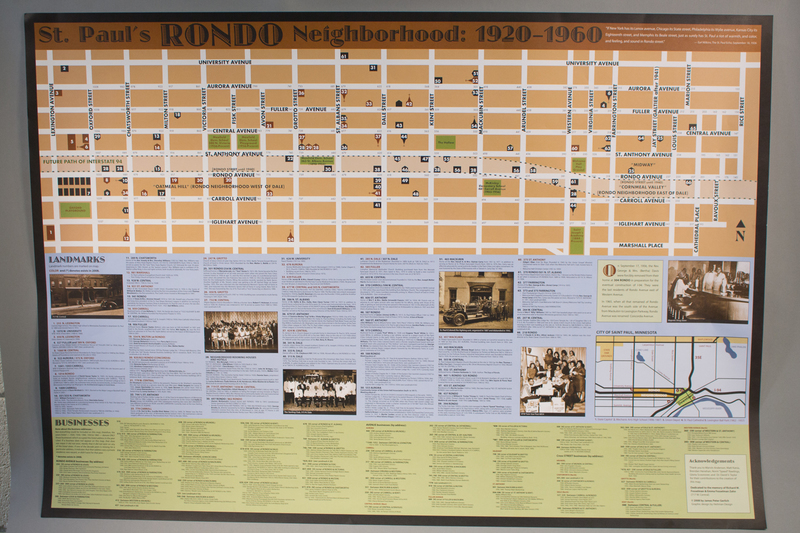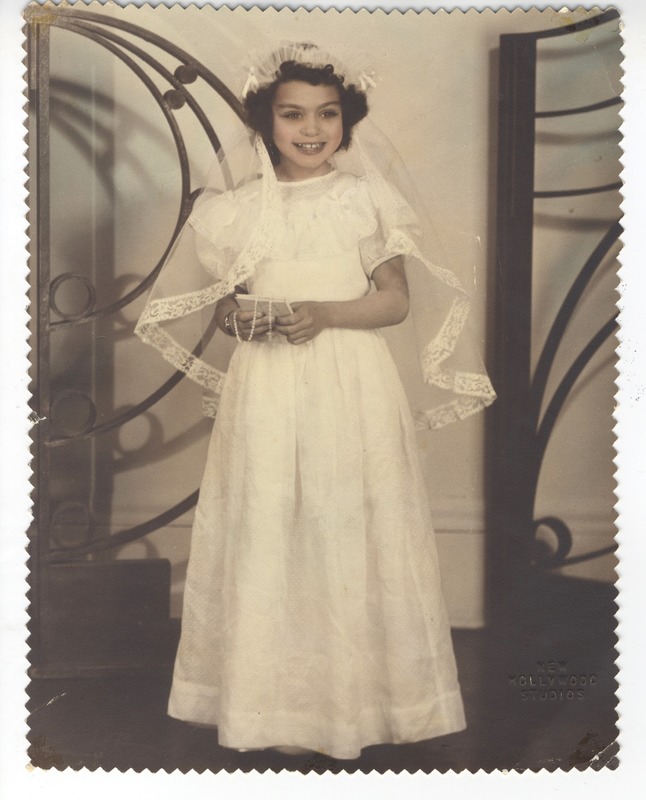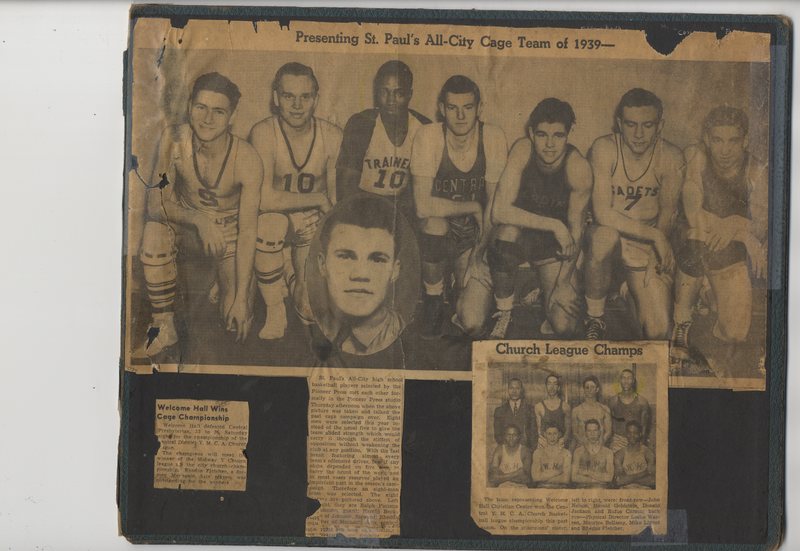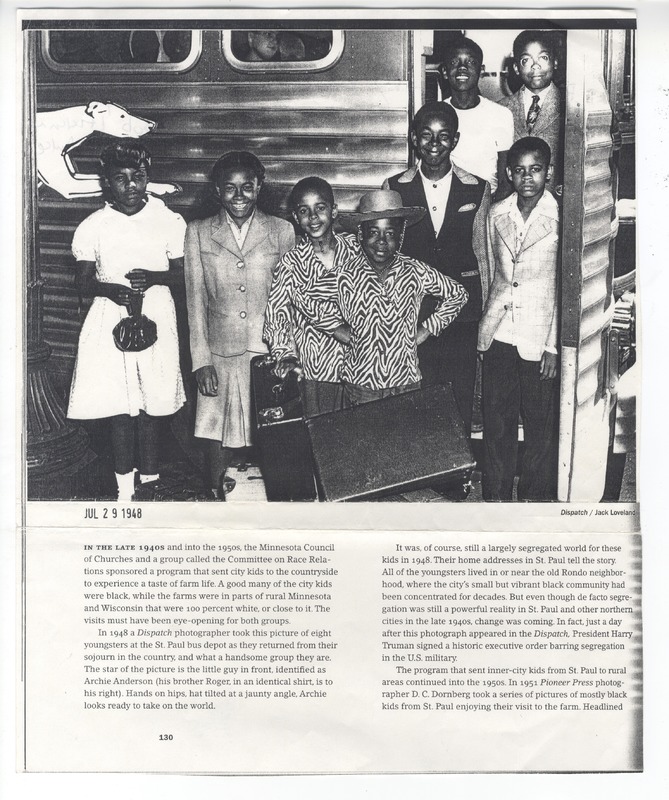Religious Life and Social Organization in Rondo
Spiritual life played a large role in the Rondo neighborhood through bringing the community together, providing a cultural touchstone, and facilitating diverse recreational activities. The religious fervor that permeated throughout the neighborhood brought connections and resources to the residents. The church and spiritual life influenced the culture of Rondo since it was so prevalent in everyday life. Jim Gerlich’s map of Rondo illustrated the presence of churches in the neighborhood, as there was at least one in every other block. Dee Dee Ray’s self portrait during her first communion depicted what went on during Sundays and the role the church had in her youth. The photographs about the YMCA Church League and the newspaper article about the field trip to a cherry grove described some of the many ways in which the church enriched the community through recreational programs.
The map of Rondo illustrates the buildings, landmarks, businesses, and churches of the Old Rondo neighborhood that affected everyday life for the residents. The map is an accurate representation of the boundaries of the neighborhood because Jim Gerlich spent years going over his work to ensure that all the information was correct. Gerlich spoke with various community members and read every edition of The Echo, the Rondo local newspaper to fact check the layout of Rondo. Saint Paul’s Rondo neighborhood map from 1920 to 1960 illustrated the prevalence of the church, for there was at least one church in every two blocks in the area above Rondo Avenue. Due to the high number of churches in the community, the Rondo residents prioritized their spiritual life and the intimacy of a church-centered community. Having many small churches instead of a few more populated churches showed how the church-goers rather have a close-knit congregation and get to know those who attend their church.
Sundays at church were taken seriously in Rondo — both inside and outside the actual sermon. The photograph of Dee Dee Ray’s first communion embodied how important religion played into the lives of the community and how serious it was taken. A communion is the service of worship where bread is broken and wine is consumed in remembrance of Jesus Christ. This is different from a regular sermon because it reminds the church member to reflect upon the core beliefs and principles of Christianity. For Ray’s first communion, her family wanted to capture this momentous event and she had a photoshoot in New Hollywood Portrait Studios wearing a beautiful white gown and veil. Setting up a photo shoot is indicative of the church's importance in Rondo families — so much that parents would arrange a formal photoshoot for their children’s first communion. What happened after the sermons in the church was also an integral part of Sundays. Evelyn Fairbanks in her book, The Days of Rondo, recalls the meals that the congregation shared after the sermon and how she anticipated it, especially after spending hours listening to the sermon. Her mother and other church members bonded through preparing together the meals for the whole congregation. Since food is considered an important aspect of Rondo culture, sharing meals in the church further depicts the intimacy of the church community as it allots time to have conversations and quality time together that isn’t solely centered on religion. The weekly meals together helped foster a bond and a greater connectedness within the congregation.
In terms of activities outside Sunday sermons, the Welcome Hall Christian Center facilitated a basketball team for high school students and participated in the YMCA Church League. Readus Fletcher Jr. brought in a newspaper article about how the team representing the Welcome Hall competed in the YMCA Church Basketball League championship after defeating Central Presbyterian Church in 1939. This basketball league was a way for high school boys to congregate, play basketball, and meet other youth within the various church communities, all while glorifying God. The Welcome Hall Christian Center opened in 1916 by a black mission congregation to provide a “center for recreational activities, Bible classes, a girls’ club, and the first day-care facility in the black community.” (1) The Welcome Hall provided an outlet for the youth to foster meaningful relationships and experiences — becoming an integral network for the Rondo residents. Another instance of the church providing activities and trips for the community was when the Minnesota Council of Churches and an organization called The Committee on Race Relations sponsored an event that sent Rondo children to experience the countryside in the late 1940s and early 1950s.The resources and trips provided to the Rondo community through the church facilitated access for what may have been previously inaccessible.
Religion had an discernible role in the culture of the Rondo, both due to the large presence of churches and the engagement that they had in the community. The artifacts ranging from the photographs to oral histories embody the spiritual life in Rondo and the overarching culture of the neighborhood.
1. Taylor, African Americans in Minnesota, 37



